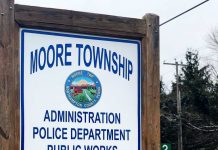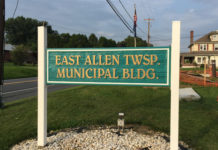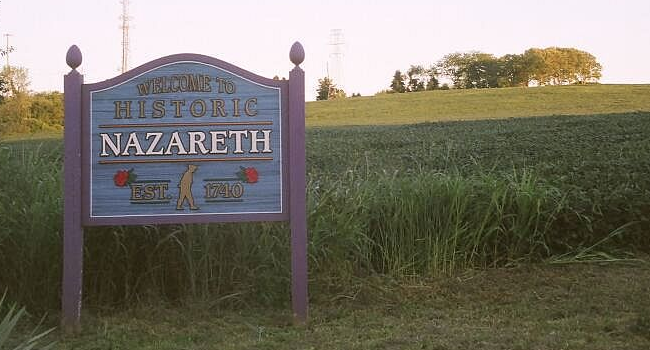The Borough of Bath held a public sub-committee “information session” on Monday, June 24 to discuss upcoming Municipal Separate Stormwater Sewer System projects, possible avenues of funding and provide residents with the opportunity to ask questions.
To explain what MS4 is, Borough Council President Frank Hesch stated that per the Pennsylvania Department of Environmental Protection, stormwater runoff is generated from rain and snowmelt events that flow over land or impervious surfaces such as paved streets, parking lots and rooftops, thus preventing the water from soaking into the ground.
The runoff picks up pollutants such as trash, chemicals, oils and dirt or sediment, which can harm streams, rivers and lakes, so to protect these resources, stormwater best management practices are used to capture and treat pollutants in the runoff using structures that collect the runoff and infiltrate it into the ground or treat and release it.
Development of urban and suburban areas are major contributors to pollutants and runoff, as well as negative impacts to waterways caused by increased volumes and rates of runoff from impervious surfaces, which also cause problematic changes in hydrology and water quality.
As part of the state’s next phase in reducing stormwater and waterway pollution, Bath has been mandated to develop a stormwater pollution prevention plan and fully implement best management practices and projects that reduce at least 10% of its stormwater pollution by Dec. 31, 2027, despite a lack of grant and funding opportunities to help cover the costs.
The borough’s current pollution production plan projects consist of two dry extended detention basins on Holiday Hill, street sweeping and a rain garden on the George Wolf Elementary School property, which will all be financed and advertised for bid together.
If the borough is unable to complete the projects by the deadline and prove they have reduced stormwater pollutants by 10%, they risk facing significant fines in the six-figure range.
Once the projects have been completed, the borough also anticipates the Department of Environmental Protection Board mandating additional MS4 requirements in the future.
In his presentation, Attorney E. Lee Stinnett from Salzmann Hughes P.C. detailed that the costs associated with these projects are estimated to be upwards of $800,000, which is why the borough is aiming to implement a stormwater utility fee that will generate approximately $200,000 in revenue annually to cover the project costs.
The growing use of stormwater fees by municipalities across the nation are used to dedicate a predictable source of funds to stormwater management that provides a steady stream of revenue for long-term planning, apportion costs fairly based on impervious coverage property characteristics, share the financial burden with all who will benefit from stormwater management services, provide credit considerations for residents who aid in water quality or other stormwater efforts on their property and also to provide an incentive for property owners to collaborate through partnerships and community projects that are also credited.
The credit program would utilize a formula to calculate credits based on the amount of each project’s pollution reduction or impervious coverage removal, which could be donated to other businesses or entities such as churches, nonprofits and schools to lower their stormwater fees.
Neighboring municipalities with higher populations such as Allentown, Bethlehem and Easton have already implemented a stormwater fee, but their impervious coverage formulas differ greatly from smaller municipalities like Bethlehem Township, Fountain Hill Borough and Palmer Township that use a tiered system.
Therefore, the borough considered three potential water authority fee options: charging a uniform rate of $236 per parcel for approximately 850 tax parcels to generate approximately $200,000 annually in revenue; a target formula of $25/quarter/base unit that would generate approximately $179,000 annually; and a tiered system based on total square feet of impervious coverage.
The borough believes the best option is to implement a tiered system that would charge $0 for properties with less than 300 square feet of impervious coverage, $20 per quarter or $80 per year for properties between 300 and 2,000 square feet, $25 per quarter or $100 per year for properties between 2,001 and 4,000 square feet and properties with 4,001 square feet or greater would be charged $30 for every 2,000 square feet quarterly or $120 per 2,000 square feet annually. This method would generate approximately $182,500 in revenue annually.
In a GIS database analysis, Bath has around 750 single family residential parcels and 4.8 million square feet of impervious area. Out of a 20% sample (150 parcels), the mean impervious area was 3,618 square feet per residential dwelling, whereas the mean of 20% (109 parcels) of the borough’s non-single family and non-residential parcels was 19,231 square feet per parcel.
Moreover, since each property’s area of impervious coverage will determine its stormwater utility fee, tax-exempt entities that often have significantly larger areas of impervious coverage such as schools, churches and other nonprofits will not be exempt from the stormwater fee.
To compare, if the borough were to raise taxes to generate the funds, it would cost residents much more and would be based on home size rather than impervious coverage, which would not be uniform, fair or equitable to residents who would need to pick up the slack for tax-exempt entities and properties with larger amounts of impervious coverage.
To accurately determine each property’s amount of impervious coverage, Madison explained that aerial photography will be used. Stinnett added that residents will be able to file appeals retroactively if they believe their property’s impervious coverage was not properly assessed.
Residents will be able to ask additional MS4 questions at future council meetings or they can schedule a one-on-one meeting with the borough manager.








